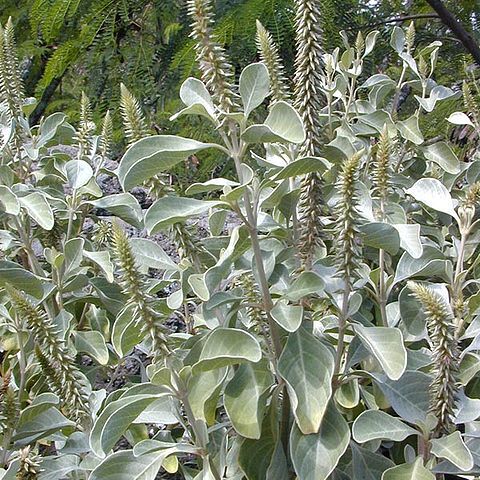Herbs with opposite, petiolate, entire leaves. Inflorescence a ± slender spike, terminal on the stem and branches, the flowers at first congested and ± patent, finally usually laxer and deflexed; bracts deltoid or ovate, the midrib excurrent in a spine. Flowers solitary in the bracts, hermaphrodite, bibracteolate. Perianth-segments 4–5, 1–3(–5)-nerved, narrowly lanceolate, acuminate, aristate with the excurrent midrib, indurate in fruit especially at the base. Bracteoles spinous-aristate with the excurrent midrib, the lamina forming short and free to longer and adnate membranous wings. Stamens 2–5; filaments filiform, monadelphous, alternating with quadrate to broadly quadrate-spathulate pseudostaminodes, these simple and dentate or fimbriate, or furnished with a variably developed dorsal scale; anthers bilocular. Ovary with a solitary pendulous ovule, the ovary wall very thin in fruit; style slender; stigma small, truncate-capitate. Entire flower with bracteoles falling with the ripening of the cylindrical seed, the deflexed bracts persistent. Endosperm copious.
Herbs, perennial or annual. Stems erect to ascending. Leaves opposite, petiolate; blade elliptic, ovate to orbiculate, or broadly rhombate, margins entire. Inflorescences terminal and axillary, pedunculate, elongate, many-flowered, simple spikes or few-branched panicles; flowers crowded together at tips, becoming more widely spaced toward base. Flowers bisexual, often becoming deflexed with age; tepals 4 or 5, basally connate, without ornamentation, coriaceous, becoming indurate in fruit, ± glabrous; filaments basally connate into short tubes or cups; anthers 4-locular; pseudostaminodes 5; ovary obovoid or turbinate; ovule 1; style elongate; stigma 1, capitate. Utricles enclosed by and falling with indurate tepals, elliptic or cylindric, membranous, indehiscent. Seeds 1, inverted, obovoid or ovoid, smooth.
Flowers perfect, bracteate and bibracteolate, subsessile in elongate spikes. Sepals 4-5, discrete, hypogynous, concave, subequal, obscurely 3-5 nerved, occa-sionally pungent. Stamens 2-5, the filaments flattened and united below forming an appendiculate tube; anthers 4--locellate, introrse, medially attached. Ovary obovoid, 1-locular, 1-ovulate; ovules campylotropous on elongate flattened funicles; style 1, filiform; stigma 1, capitate. Fruit a membranaceous turbinate indehiscent utricle; seeds cochleate-orbiculate, reddish brown. Glabrous to pubescent erect or decumbent annual or perennial herbs. Leaves opposite, short-petiolate, scantily appressed strigose to sericeous, deciduous. Inflorescences of terminal and axillary spikes, the flowers deflexed in age, the spinose tips of the bracts not uncinate.
Herbs, sometimes shrubs or trees, perennial, erect, covered with short white simple hairs, densest on new growth. Leaves opposite, petiolate, dark green above, lighter below. Inflorescence a spike elongating with maturity, terminal or axillary. Bracts sessile, reflexed, persistent, with apex aristate. Flowers bisexual, sessile. Bracteoles sessile, falling with fruit; apex spinescent. Tepals 5, free, subequal; apex acuminate, not spinescent, falling with fruit. Stamens 5, fused at base into short cup; anthers bilocular; staminodes 0; pseudostaminodes 5, alternating with stamens. Ovule 1; style single; stigma capitate. Fruit an indehiscent utricle, dispersed as a unit with bracteoles and perianth, reflexed at maturity. Seed 1, smooth; walls semifused with ovary.
Annual herbs, sometimes fruticose. Leaves opposite, petiolate. Inflorescence of terminal spikes; bract persistent; bracteoles located on outer side of reflexed flower, becoming indurated with spinose apex. Flowers sessile, becoming reflexed early in development; tepals 5, stiff, persistent; stamens 5, separated by 5 fimbriate pseudostaminodia, filaments and pseudostaminodia joined below in a cup, anthers dorsifixed; style filiform, stigma glandular. Fruit an indehiscent, thin-walled utricle, remaining inside persistent tepals and bracteoles; seed 1, more or less cylindrical, testa thin, membranous, pale brown, embryo closely encircling solid perisperm.
Herbs, often woody towards base, shrubs, or very rarely trees. Lvs opposite, petiolate. Spikes terminal or axillary, many-flowered, often elongating greatly after flowering. Fls solitary, axillary, deflexed after anthesis; bract scarious, acute to acuminate, persistent, subtended by 2 spiny bracteoles. Tepals 5-lobed, spreading during anthesis, afterwards erect, membranous or coriaceous, pungent or not in fr. Stamens 5, much < perianth, alternating with staminodes; filaments connate at base into a cup. Ovary glabrous; ovule 1, pendent; stigma capitate. Fr. an utricle, indehiscent, dry, falling with the often spiny perianth and bracteoles.
Herbs or subshrubs. Stem with conspicuous nodes; branches opposite. Leaves opposite, petiolate. Spikes terminal or axillary, erect. Flowers reflexed or spreading, perfect, with 3 bracts; midvein of bracteoles spiny, long, excurrent. Tepals 4 or 5, membranous, apex awn-pointed, rigid in fruit. Stamens 5, rarely 4 or 2, shorter than perianth; filaments connate into a short cup at base, pseudostaminodes fringed; anthers 2-loculed. Ovary oblong; style linear, persistent; stigma capitate. Utricles ovoid-oblong, ovoid, or subglobose, falling off with tepals and bracteoles. Seed oblong, lenticular.
Fls perfect; sep 4–5, distinct, erect, firm-chartaceous; stamens connate below to form a short tube with (4)5 alternating filaments and as many alternating sterile lobes; anthers tetrasporangiate and bilocular; style solitary, with a capitate stigma; ovule one; utricle membranous, indehiscent; herbs with opposite, petiolate, entire lvs and greenish fls in elongate, terminal and axillary spikes. 100, Old World.

